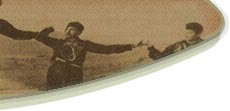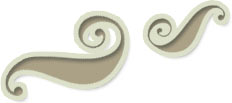|
 
:
The Threshing Floor
:
The Lyre Player
: Virgin Mary of Harakas
:
Legends of Fragokastelo
:
Drosoulites
Over
600 years in this remote corner of the Cretan ground, in Fragokastelo,
today is raised the devastated castle that was built by he
Venetians in order to keep in subjugation the residents of
Sfakias. The hundreds of the Greek visitors that come in order
to enjoy the sea, observe it with an indifference that often
reaches the limits of abomination, as if they continue the
scorn and the animosity that the locals showed in its revelation.
Let's
remember the story:
In 1340 the feudal lords of Chania asked from Venice to build
a fortress near the church of Saint Nikitas, in Sfakia, to
secure the creek from the piratical raids, but moreover to
have a support for the ęrepression of the rebellionsĽ of residents
of the region. The Democracy of Saint Mark did not have any
objection to the construction, but did not give the essential
amount of money. However, under the insistence of the feudal
lords it receded and in 1371 the construction of the fortress
was decided.
The Venetians brought workers, craftsmen, carriers, etc and
started to work. They were in a hurry to finish as soon as
possible, because they were afraid to stay for long in this
dangerous place. And they were right to be afraid. The locals,
as soon as they realized the intentions of the conquerors,
they made a raid and they slaughtered enough of them. The
losses were supplemented and simultaneously powerful metres
of safety were taken: the army was guarding all day the workers
and in the evening all of them with boats were going to the
ships that were anchored and spending the night there.
But the locals with leaders the Patsos', six heroic brothers,
at night they were tearing down what the Venetians were building
during the day and simultaneously they were spoiling the lime-kilns.
How can the castle be built like this?
The
conquerors then brought a lot of army, guarding the place
all around day and night, and the castle was built. In this
time they managed to capture the six brothers, and hung them
in the towers and in the entry of the fortress...
But the story of the castle does not finish here: In the years
of the Ottoman domination, it passed, as it is natural, in
the hands of the new conquerors
and here came the first martyr of Freedom, Daskalogiannis
with the 70 revolutionists and were delivered to the Turks.
But
the day that stood dramatic for the castle was the 18th of
May 1828. That day beame a holocaust. Hatzi Mihalis Ntalianis,
the fighter from Epirus, that carried away from the fights
and the sacrifices of our ancestors, came in our bloodstained
island with 100 raiders and 600 people of infantry, to help
the revolution that was flickering. He stood front of this
castle, decided to stop Moustafa pasha. He gave his life for
the freedom of Crete, with his 385 fearless soldiers...
In
front of the Fragokastelo became a wild slaughter. Even the
embrasures of the castle saw heroisms that no language can
describe. From the death-rattle the place shaked all over
and the blood ran like a river and the ground was dyed red...
Later on, as it becomes always, all quietened. And the marks
of the slaughter become less day by day. And they might be
extinguished some time, if it wasn't for the Drosoulites that
maintain this memory alive, the sacrifice of the braves.
On
May 17th-18th, on the time it begins to faintly lighten, the
time that the shades of the thickets play as they are prepared
to meet the sun, the time that the dewdrops cover the branches
that remain still in the calm of the morning, is presented
an army, an escort of shadows, a line of figures that they
do not distinguish if they are human or not and they move,
as in a parade, from the monastery of Saint Haralampis towards
the Fragokastelo. They are dressed in black, some of them
walk and others ride, they wear helmets, keep arms and swords
that sparkle. They are the Drosoulites. When someone approaches,
they leave and disappear in the sea... Those who see them,
because not everyone sees them, believe that they are the
souls of the killed ones that come back to the castle on each
anniversary of the slaughter.
The
scientists do not agree with this explanation, but can science
explain everything?So many mysteries exist around us. ..
Such a mystery is certainly the Drosoulites. And if you find
yourself there they show, you will agree with the George Manousakis,
that ęthe Drosoulites are the deads of the Fragokastelo, as
the locals see them with their plain incorruptible glance
and as they explain this phenomenon with their myth-making
imagination. Who certifies that doesn't exist a door from
where "here" communicates with "there"?
For those who live in the wider embrace of nature, in harmony
with its vigorous rhythm, these two worlds, this of the bodies
and the other of the shadows, are in continuous communication.
The souls of the killed ones go up in the earth that lived
and died, to see again the sea and the light, to breathe the
smell of the thyme and the sage that come from mount Madara,
to feel the morning dew and to remember the beauties of the
ground and their bloody sacrifice. And the living see them
and get scared with the presence in in the space of their
daily life of this escort, that comes from the unknown after-death
world, as if it confirms its existence. People and supernatural
shadows walk on the same ground in an absolute reconciliation.
:
The Interpretation of the Legend
During
the First World War, during the battle of Mons of Belgium,
fell in the perception of thousands of soldiers a curious
phenomenon, of moving human shades above the fighting soldiers,
and then the name of "the angels of Mons" was given.
The English press was dealing for some time with this, they
gave for the description of this phenomenon various explanations
from people involving with psychic and spiritualistic phenomena.
Finally "the angels of Mons" remained a historic
and unexplained incident until today. Thus therefore they
made their appearance, on the Island of Crete in the Venetian
and devastated fortress of Fragokastelo, "the Drosoulites".
A
lot of years ago, the Chairman of the Botanic Company of London,
mr G. Baker, visited Crete so as to collect rare herbs. During
his stay in a hotel of the region, the villagers began to
narrate the story about the "ghosts" that are visible,
almost every year. The tone and the detail narration caused
a big impression to mr Baker, as also himself was dealing
with spiritualistic phenomena, and the opinion he shaped was
that it is not some accidental make, or some usual myth of
the Cretan tradition, but that behind this phenomenon is hidden
a genuine story.
He
decided therefore to come back next May, having first asked
from somebody collect information. The information was the following:
Each year, around the middle of May and when the wheather is
foggy, a few minutes before the east of the sun, in the region
of Thime Campos, and to the fortress of Fragokastelo, parades
from the west to the east, a crowd of shades of horsemen and
pedestrian soldiers, with helmets and swords. As the sun rises
this shades slowly become imperceptible, and disappearred completely
as soon as the first beams of the sun shine. The phenomenon
lasts roughly 8 minutes of the hour. In any case it is a uncontradictable
historical event with interesting information but still unexplained
from a scientific point of view... |


|





